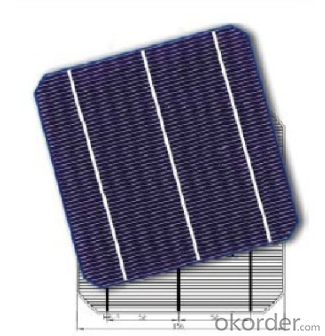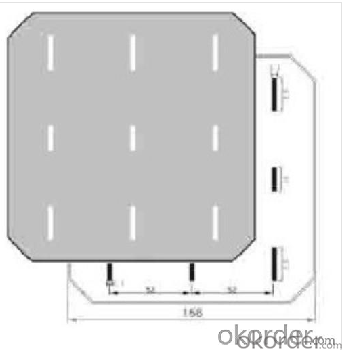Monocrystalline Solar Cells for Sale - 156mmx156mm Mono Solar Cell
- Loading Port:
- Shanghai
- Payment Terms:
- TT OR LC
- Min Order Qty:
- 500 PCS
- Supply Capability:
- 10000000 PCS/month
OKorder Service Pledge
OKorder Financial Service
You Might Also Like
1.Product Description:
Monocrystalline solar cells are currently the fastest developing a solar cell, its structure and production process has been finalized, the products have been widely used for space and ground. Such solar cells with high purity silicon rods as raw materials. Silicon rods, material performance indicators in order to reduce production costs, and now solar terrestrial applications such as the use of solar grade somewhat relaxed. Some semiconductor devices can also be used for processing materials and discard the head and tail of silicon materials, solar cells after re-drawn into a dedicated silicon rods
2.Specifications Of Mono Solar Cell 156mm
1.Mechanical data and design
Format | 156 mm × 156 mm ± 0.5 mm |
Thickness | - 210 μm ± 40 μm |
Front(-) | 1.5 mm bus bars (silver),blue anti-reflection coating (silicon nitride) |
Back (+) | 2.5 mm wide soldering pads (silver) back surface field (aluminium) |
2.Temperature Coefficient of Cells
Voc. Temp . coef.%/K | -0.35%/K |
Isc . Temp . coef.%/K | +0.024%/K |
Pm. Temp. coef.%/K | -0.47%/K |
3:PACKING :
Packaging & Delivery Of Mono Solar Cell 156mm | |
Packaging Detai | Packaging Detail:Export Carton and Pallet or under customer request. |
Delivery Detail:10-20days | |
4.IMAGES:

5.FAQ:
WHAT'S YOUR ADVANTAGES OF YOUR PRODUCTS?
1: high quality cell, Level A cell
2: Dimensione:125*125mm Diagonal:150mm / 165mm
Dimensione:156*156mm Diagonal:200mm
3: Qualified certification: TUV,CE certification.
4: Warranty: five years for whole unit
- Q: Can solar cells be used to power off-grid cabins or homes?
- Yes, solar cells can definitely be used to power off-grid cabins or homes. Solar panels can convert sunlight into electricity, which can then be stored in batteries for use during the night or when the sun is not shining. This renewable energy source provides a sustainable and reliable power solution for off-grid living, reducing dependence on traditional energy sources.
- Q: Can solar cells be used for powering space missions?
- Yes, solar cells can be used for powering space missions. Solar cells, also known as photovoltaic cells, convert sunlight into electricity. They have been widely used in space missions as they provide a reliable and renewable source of energy. Solar panels equipped with these cells are often deployed on spacecraft to generate power for various systems and instruments. The abundance of sunlight in space makes solar cells a practical and efficient option for powering space missions.
- Q: Can solar cells be used for powering remote communication towers?
- Yes, solar cells can be used to power remote communication towers. Solar panels can be installed on the towers or nearby to capture sunlight and convert it into electricity. This renewable energy source is ideal for remote locations where access to traditional power grids may be limited or costly. Solar cells can provide a reliable and sustainable power supply for remote communication towers, enabling them to function efficiently.
- Q: Solar panel resistance is changed with what
- To be sure that this question is very professional. Secondly, I have to answer this question: the internal resistance of solar energy, mainly reflected in the power generation, the inhibition of current. In the time of power generation,
- Q: How long do solar cells last?
- Solar cells typically have a lifespan of around 25 to 30 years. However, with proper maintenance and regular cleaning, solar cells can continue to generate electricity for even longer periods.
- Q: Can solar cells be used in space stations?
- Yes, solar cells can be used in space stations. In fact, they are commonly used to provide power to space stations by converting sunlight into electricity.
- Q: Can solar cells be used in space?
- Yes, solar cells can be used in space. In fact, they are commonly used in space missions to generate electricity from the sunlight in the absence of an atmosphere. Spacecraft and satellites often rely on solar cells to power their systems and equipment.
- Q: Are solar cells environmentally friendly?
- Yes, solar cells are environmentally friendly. They produce clean and renewable energy by harnessing sunlight, which reduces dependence on fossil fuels and lowers greenhouse gas emissions. Additionally, solar cells do not produce any air or water pollution during operation, making them a sustainable and eco-friendly energy source.
- Q: What materials are used in solar cells?
- The most common materials used in solar cells are silicon, which is the dominant material in the market, as well as other materials such as cadmium telluride, copper indium gallium selenide, and organic materials like polymers.
- Q: How does a solar cell raise industrial efficiency?
- By providing more power and using less energy.
Send your message to us
Monocrystalline Solar Cells for Sale - 156mmx156mm Mono Solar Cell
- Loading Port:
- Shanghai
- Payment Terms:
- TT OR LC
- Min Order Qty:
- 500 PCS
- Supply Capability:
- 10000000 PCS/month
OKorder Service Pledge
OKorder Financial Service
Similar products
Hot products
Hot Searches
Related keywords




























